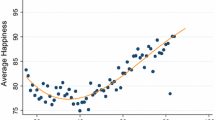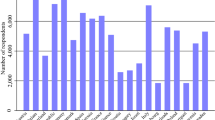Abstract
Age effects and birth cohort effects have not been differentiated in happiness studies. In this paper, age-period-cohort decomposition is applied to happiness data in the US. Since the relationship is linear, such as age = period − cohort, it is not possible to identify the three effects. This paper considers four identification models: the polynomial age-effect model, the proxy-variable model, the orthogonal period-effect model, and the principal component model. Happiness data are obtained from the General Social Survey for 1972–2008. Except for the polynomial age-effect model, three alternative models provide similar results. In particular, there is little difference between the decomposition results obtained by the orthogonal period-effect model and by the principal component model. The age effect shows downward movements for 18–55 and for 80–89, an upward movement for 56–69, and an almost flat movement for 70–79. The period effect shows cyclical movements slightly similar to unemployment rates fluctuations. The cohort effect shows a downward movement for the birth cohorts of 1894–1936, a dip for 1945–1958 (baby boomers), an upward movement for 1959–1969, and an almost flat movement for 1970–1987.


Similar content being viewed by others
Notes
Health status is an important factor for happiness and adopted in Yang (2008), but is not considered here because of sample loss (more than 5,000 samples). In 1978, 1983, and 1986, this variable was neglected in the GSS.
Homeownership, denoted by “dwelown” in the GSS, is an important factor for happiness and adopted by Powdthavee (2005) and Luttmer (2005), but is not considered here. This variable was neglected in 1972–1984. Similarly, whether the respondent lives in an urban or rural area is an important issue for happiness and adopted by Di Tella and MacCulloch (2008) and Powdthavee (2005), but this variable, denoted by “srcbelt” in the GSS, is not considered here. This variable was not available in 2008.
Myers and Lumbers (2008) note that the late baby boomers grew up in an optimistic era of technological advancements and growing social awareness and that their consumer confidence is based on the economy prospering.
The three pairs are as follows. First, the correlation coefficient is −0.48 for “Income 1” (lower income) and “Income 2” (higher income). Second, the correlation coefficient is 0.44 for “Attendance 1” and “Religion.” These correlations are self-evident and the exclusion of one variable from four variables has little influence on regression results. Finally, the correlation coefficient is 0.59 for “Single” and “Children (no children).” This correlation is also self-evident but the exclusion of the variable of “Single” changed the sign of the regression coefficient for “Children” plus to minus. However, this result is reasonable, since the statistical significance of the variable “Single” is much larger than that of the variable “Children.”.
References
Attanasio, O. P. (1998). Cohort analysis of saving behavior by U.S. households. Journal of Human Resources, 33, 575–609.
Benson, J., & Brown, M. (2011). Generations at work: Are there differences and do they matter? International Journal of Human Resource Management, 22, 1843–1865.
Blanchflower, D. G., & Aswald, A. J. (2004). Well-being over time in Britain and the USA. Journal of Public Economics, 88, 1359–1386.
Deaton, A., & Paxson, C. (1994). Saving, growth, and aging in Taiwan. In D. A. Wise (Ed.), Studies in the economics of aging (pp. 331–357). Chicago: Chicago University Press for NBER.
Di Tella, R., & MacCulloch, R. (2008). Gross national happiness? As an answer to the Easterlin Paradox. Journal of Development Economics, 86, 22–42.
Di Tella, R., MacCulloch, R. J., & Oswald, A. (2001). Preferences over inflation and unemployment: Evidence from surveys of happiness. The American Economic Review, 91, 335–341.
Diener, E. (1984). Subjective well-being. Psychological Bulletin, 95, 542–575.
Easterlin, R. A. (1974). Does economic growth improve the human lot? Some empirical evidence. In R. David & M. Reder (Eds.), Nations and households in economic growth: Essays in honor of Moses Abramovitz (pp. 89–125). New York: Academic Press.
Easterlin, R. A. (1980). Birth and fortune: The impact of numbers on personal welfare. Chicago: Chicago University Press.
Easterlin, R. A. (1995). Will raising the incomes of all increase the happiness of all? Journal of Economic Behavior & Organization, 27, 35–47.
Ferrer-i-Carbonell, A., & Frijters, P. (2004). How important is methodology for the estimates of the determinants of happiness? Economic Journal, 114, 641–659.
Fukuda, K. (2010). Household Behavior in the US and Japan: Cohort analysis. New York: Nova Science Publishers.
Fukuda, K. (2011). Age-period-cohort decompositions using principal components and partial least squares. Journal of Statistical Computation and Simulation, 81, 1871–1878.
Giuliano, P., & Spilimbergo, A. (2009). Growing up in a recession: Beliefs and the macroeconomy. NBER Working Paper No. 15321.
Gove, W. R., Ortega, S. T., & Style, C. B. (1989). The maturational and role perspectives on aging and self through the adult years: An empirical evaluation. American Journal of Sociology, 94, 1117–1145.
Hayo, B., & Seifert, W. (2003). Subjective economic well-being in Eastern Europe. Journal of Economic Psychology, 24, 329–348.
Heckman, J., & Robb, R. (1985). Using longitudinal data to estimate age, period, and cohort effects in earnings equations. In W. M. Mason & S. E. Fienberg (Eds.), Cohort analysis in social research (pp. 137–150). New York: Springer.
Jianakoplos, N. A., & Bernasek, A. (2006). Financial risk tanking by age and birth cohort. Southern Economic Journal, 72, 981–1001.
Kalwij, A. S., & Alessie, R. (2007). Permanent and transitory wages of British men, 1975–2001: Year, age and cohort effects. Journal of Applied Econometrics, 22, 1063–1093.
Luttmer, E. F. P. (2005). Neighbors as negatives: Relative earnings and well-being. Quarterly Journal of Economics, 120, 963–1002.
Myers, H., & Lumbers, M. (2008). Understanding older shoppers: A phenomenological investigation. Journal of Consumer Marketing, 25, 294–301.
Oswald, A. J., & Powdthavee, N. (2008). Does happiness adapt? A longitudinal study of disability with implications for economists and judges. Journal of Public Economics, 92, 1061–1077.
Powdthavee, N. (2005). Unhappiness and crime: Evidence from South Africa. Economica, 72, 531–547.
Rao, C. R., & Mitra, S. K. (1971). Generalized inverse of matrices and its applications. New York: Wiley.
Ryder, N. B. (1965). The cohort as a concept in the study of social change. American Sociological Review, 30, 843–861.
Stutzer, A. (2004). The role of income aspirations in individual happiness. Journal of Economic Behavior & Organization, 54, 89–109.
Yang, Y. (2008). Social inequalities in happiness in the United States, 1972 to 2004: An age-period-cohort analysis. American Sociological Review, 73, 204–226.
Acknowledgments
I am grateful to the editor in chief and the anonymous reviewers for very constructive comments and suggestions. Needless to say, any remaining errors are mine.
Author information
Authors and Affiliations
Corresponding author
Appendix: The Identity Between the Parameter Estimates Obtained by the OPE Model and by the PC Model
Appendix: The Identity Between the Parameter Estimates Obtained by the OPE Model and by the PC Model
Based on aims and scope of the journal, not a purely mathematical proof but a few hints concerning this identity are provided. The regression model (1) for I age groups, J survey periods, K birth cohorts, and N explanatory variables is re-specified as follows.
where Y is the T × 1 (T = I × J) vector of happiness data, X is the T × (M + N) (M = I + J + K − 3) matrix for age, period, and cohort effects dummies and explanatory variables, β is the parameter vector to be estimated, and e is the vector of the disturbance term. X can be partitioned as X = (DE), where D is T × (I + J + K − 3) design matrix corresponding to age, period, and cohort effects dummies, and E is T × N matrix composed of explanatory variables. The OLS estimates for the model (3) is obtained as
I newly define as (X′X)−1 X′ = (P′Q′)′, where P is M × T matrix for age, period, and cohort effects, and Q is N × T matrix for explanatory variables. The parameter estimates for explanatory variables is calculated as QY. Q is obtained as follows.
The Eq. 4 shows that the matrix D(D′D)−1 D′ is essential to the identity. Since the linear relationship between age, period, and cohort effects, the rank of the matrix D ′ D is not M but M − 1, not ordinal inverse (D ′ D)−1 but generalized inverse matrix (D′D)− is applied. Based on Rao and Mitra (1971), the following result is obtained.
Furthermore, the generalized inverse for D′D is not unique. In the present paper, the OPE model and PC model provide different matrices of the generalized inverse for D′D, while both models make the rank of D′D(M − 1). The Eq. 5 shows that the matrix Q in (4) obtained by the OPE model is completely the same as that obtained by the PC model. Hence, the identity is obtained.
Rights and permissions
About this article
Cite this article
Fukuda, K. A Happiness Study Using Age-Period-Cohort Framework. J Happiness Stud 14, 135–153 (2013). https://doi.org/10.1007/s10902-011-9320-4
Published:
Issue Date:
DOI: https://doi.org/10.1007/s10902-011-9320-4




